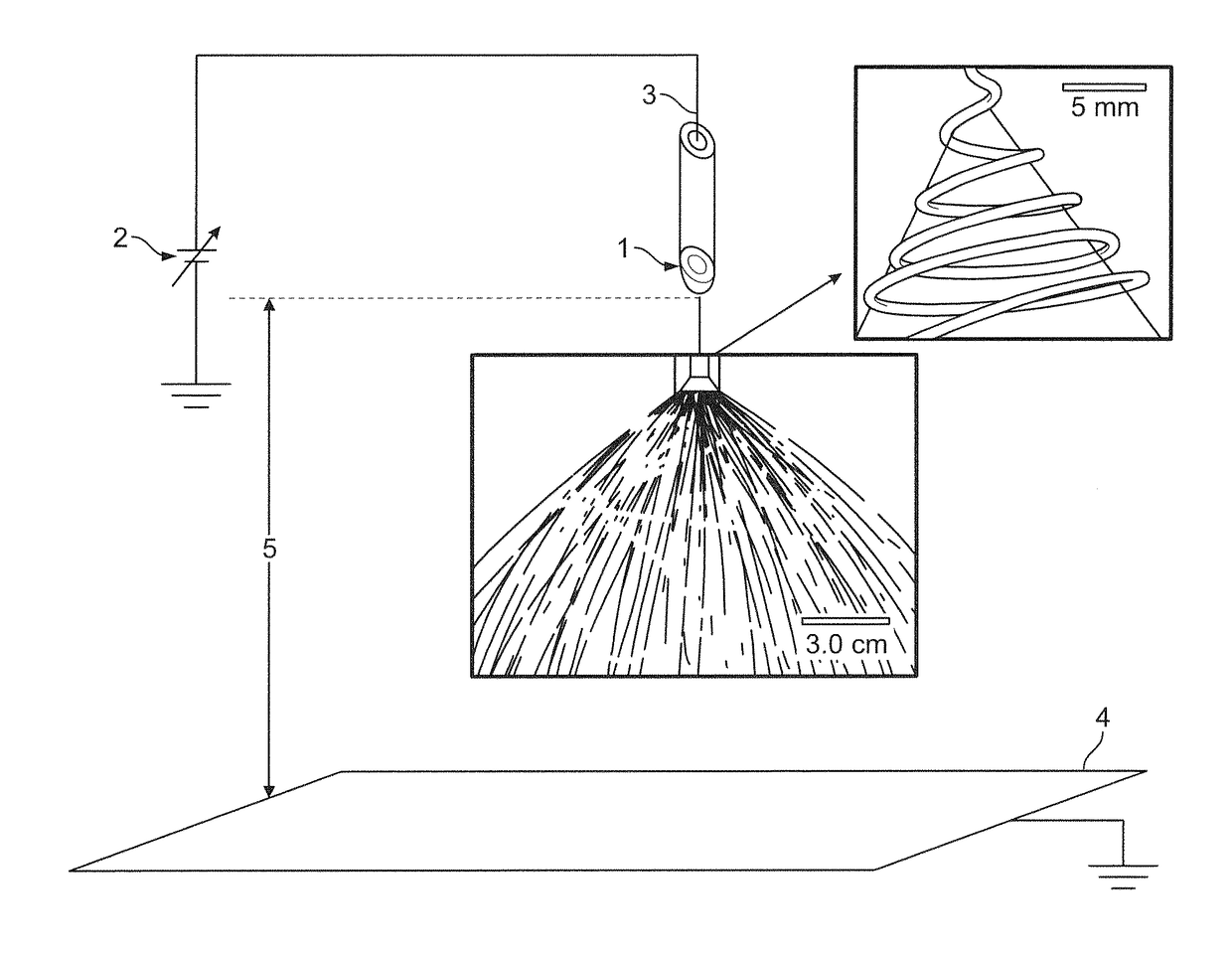Hybrid felts of electrospun nanofibers
a technology of electrospun nanofibers and hybrid felts, which is applied in the direction of anion exchangers, alkali metal oxides/hydroxides, and amphoteric ion exchangers, etc., can solve the problems of limited yield, processing time and purity, and limit the ability of the purified substance (i.e., the “target substance”) to access the binding sites deep within the separation matrix, etc. system can only be used for a limited number of cycles
- Summary
- Abstract
- Description
- Claims
- Application Information
AI Technical Summary
Benefits of technology
Problems solved by technology
Method used
Image
Examples
example 1
Preparation of Prior Art Cellulose Acetate Single Component Nanofiber Felt
[0107]A cellulose acetate single component nanofiber felt was made as described in: Handbook of Membrane Research, Chapter 3, Applications of Electrospun Nanofiber Membranes for Bioseparations, Todd J. Menkhaus, et al, Nova Science Publishers, Inc., edited by Stephan V. Gorley. Cellulose acetate (average molecular weight of ˜30,000 g / mol), NaOH, NaCl, acetone, N,N-dimethylacetamide (DMAc) and N,N-dimethylformamide (DMF) were purchased from the Sigma-Aldrich Co. (Milwaukee, Wis.). 2-(diethylamino) ethyl chloride hydrochloride (DAECH) with the purity of 98% was purchased from the Alfa Aesar Co. (Ward Hill, Mass.).
[0108]A solution of 15% (mass fraction) cellulose acetate in acetone / DMAc (mass ratio of 2 / 1) was prepared at room temperature. The solution was added to a syringe. The electrospinning setup included a high voltage power supply and a laboratory produced roller. During electrospinning, a positive high vo...
example 2
Preparation of a Hybrid Nanofiber Felt of CA / PEO Composite Nanofibers and PAN Single Component Nanofibers
[0110]Cellulose acetate (CA), polyethylene oxide (PEO), chloroform (CHCl3), dimethylformamide (DMF), polyacrylonitrile (PAN), and diethyl amino ethyl chloride were purchased from Sigma-Aldrich Co. (Milwaukee, Wis.).
[0111]The spin dopes of PAN and CA+PEO were prepared separately. Briefly, for the preparation of PAN spin dope, the PAN was dissolved in DMF to make a solution. For the CA+PEO spin dope, CA plus PEO in CHCl3 / DMF with diethyl amino ethyl chloride was prepared.
[0112]During the electrospinning process two syringes loaded with spin dope of PAN or CA+PEO were placed in the opposite side of the laboratory produced roller. Overall, the electrospinning process was very stable and was sustainable for long periods (>48 hours), and the electrospun hybrid nanofibrous mats consisting of CA+PEO composite nanofibers and PAN nanofibers (either self-supporting or supported on medical-g...
example 3
Preparation of a Hybrid Nanofiber Felt of CA / PVP Composite Nanofibers and PAN Single Component Nanofibers
[0114]Cellulose acetate (CA), polyvinylpyrrolidone (PVP), chloroform (CHCl3), dimethylformamide (DMF), polyacrylonitrile (PAN), and diethyl amino ethyl chloride were purchased from Sigma-Aldrich Co. (Milwaukee, Wis.).
[0115]The spin dopes of PAN and CA+PVP were prepared separately. Briefly, for the preparation of PAN spin dope, the PAN was dissolved in DMF to make a solution. For the CA+PEO spin dope, CA plus PVP in CHCl3 / DMF with diethyl amino ethyl chloride was prepared.
[0116]During the electrospinning process two syringes loaded with spin dope of PAN or CA+PVP were placed in the opposite side of the laboratory produced roller. Overall, the electrospinning process was very stable and was sustainable for long periods (>48 hours), and the electrospun hybrid nanofibrous mats consisting of CA+PVP composite nanofibers and PAN nanofibers (either self-supporting or supported on medical...
PUM
| Property | Measurement | Unit |
|---|---|---|
| diameters | aaaaa | aaaaa |
| diameters | aaaaa | aaaaa |
| diameters | aaaaa | aaaaa |
Abstract
Description
Claims
Application Information
 Login to View More
Login to View More - R&D
- Intellectual Property
- Life Sciences
- Materials
- Tech Scout
- Unparalleled Data Quality
- Higher Quality Content
- 60% Fewer Hallucinations
Browse by: Latest US Patents, China's latest patents, Technical Efficacy Thesaurus, Application Domain, Technology Topic, Popular Technical Reports.
© 2025 PatSnap. All rights reserved.Legal|Privacy policy|Modern Slavery Act Transparency Statement|Sitemap|About US| Contact US: help@patsnap.com



